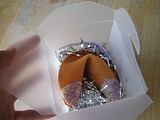
This past Saturday I was awake for 20 hours straight, to attend the 1,000 minute excerpt of
Jem Finer's
Longplayer at
YBCA. Longplayer is a conceptual piece of music that takes 1,000 years to unfold. It is currently being performed by a computer at a
lighthouse in London, but it is also possible for musicians to perform it live, which is what I witnessed on Saturday. The
instrument consists of curved tables arranged in 6 concentric rings, representing a sort of planetary system. The instrument covered almost the entire floor of the YBCA's Forum room, leaving only a narrow space along the walls for the audience. The players strike & rub singing bowls arranged on the tables according to an algorithm that cycles, with slight shifts, every 2 minutes. The bowls are in a range of sizes, & the lowest ones you can feel vibrating through the floor. The bowls were amplified, which unfortunately flattened out the sound. The motion of the music is stately & slow. Sometimes several bowls resonate at once, creating elaborate, beating overtones. Patterns of chimes move in & out of phase. In the late evening a drone began on one of the lower pitches, & it continued until the end of the performance. Perhaps the most natural response to the music is to sit on the floor & meditate, which I saw one woman do for over an hour in the late afternoon.
The purpose of Longplayer is to explore issues of long-term continuity. Because of the performance aspect, Longplayer probably does an even better job than the
Clock of the Long Now of raising questions about sustainability. 18 musicians played in one-hour shifts to keep the piece going for the 1,000 minutes. The act of one player handing his stopwatch & mallet to another player was a metaphor for the passing down of cultural traditions.
My ticket for this event allowed me to wander in & out of the performance, as well as to attend the
Long Conversation, a 6 hour marathon of talks at the
Contemporary Jewish Museum. I had hoped to hear
Danny Hillis speak, but he had to cancel due to illness. I did get to hear
Stewart Brand, though, who made an interesting connection between Longplayer & the practice of change ringing. I also took advantage of entrance to the CJM to view the happy
Maira Kalman show.
I was present when the music began at 7am, when there were more performers than audience. Altogether I heard about 4 hours of the piece. I was curious to see how they would end it, so I was back for the final hour, when there were about 40 audience members. The composer was in the rotation, & at 11:40pm he struck a pair of hand cymbals twice, at which point the musicians dropped out one by one as the lights dimmed. The ensuing silence was so pure that the only sound was the hum of the sound system. After perhaps 2 minutes, someone broke the spell by starting applause. When someone jokingly yelled, "Encore!", one of the musicians replied, "Come back in a thousand years!"
As I was about to leave, someone put a glass of champagne in my hand. I may have been mistaken for a staff member of Longplayer. So I stayed around to hear the director of the Long Now & the composer give their thanks to the assembled participants. I also chatted briefly with one of the musicians, who introduced himself as "
Mole." I was glad to hear that the experience of playing the piece does not feel rote or mechanical & that the musicians do plenty of listening while they perform.
§ Longplayer Live
Saturday October 16, 02010 - San Francisco, CA
Longplayer 7am-11:40pm at Yerba Buena Center for the Arts
Long Conversation 3pm-9pm at the Contemporary Jewish Museum





















